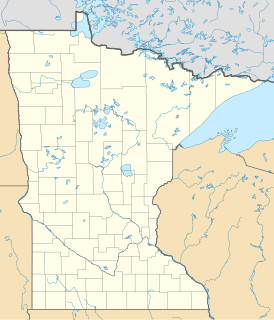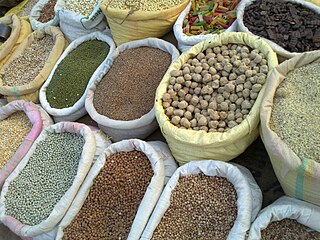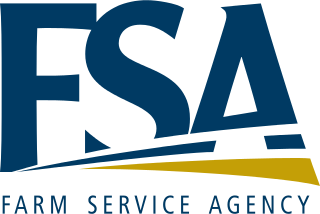The Commodity Credit Corporation (CCC) is a wholly owned United States government corporation that was created in 1933 to "stabilize, support, and protect farm income and prices". The CCC is authorized to buy, sell, lend, make payments, and engage in other activities for the purpose of increasing production, stabilizing prices, assuring adequate supplies, and facilitating the efficient marketing of agricultural commodities.

The Federal Agriculture Improvement and Reform Act of 1996, known informally as the Freedom to Farm Act, the FAIR Act, or the 1996 U.S. Farm Bill, was the omnibus 1996 farm bill that, among other provisions, revises and simplifies direct payment programs for crops and eliminates milk price supports through direct government purchases.

Rancho Los Amigos National Rehabilitation Center is a rehabilitation hospital located in Downey, California, United States. Its name in Spanish means "Friends' Ranch".

Solar power in Australia is a growing industry. As of January 2019, Australia had over 11,085 MW of installed photovoltaic (PV) solar power, of which 3,871 MW were installed in the preceding 12 months. In 2017, 23 solar PV projects with a combined installed capacity of 2,034 MW were either under construction, constructed or due to start construction having reached financial closure. PV accounted for 3.8% of Australia's electrical energy production in 2017.

Food rescue, also called food recovery or food salvage, is the practice of gleaning edible food that would otherwise go to waste from places such as restaurants, grocery stores, produce markets, or dining facilities and distributing it to local emergency food programs.

The San Gorgonio Pass wind farm is a wind farm located on the eastern slope of the San Gorgonio Pass in Riverside County, just east of White Water, California, United States. Developed beginning in the 1980s, it is one of three major wind farms in California, along with those at Altamont and the Tehachapi Passes. The gateway into the Coachella Valley, the San Gorgonio Pass is one of the windiest places in Southern California.
Natural gas, like many other commodities, can be stored for an indefinite period of time in natural gas storage facilities for later consumption.
The U.S. central banking system, the Federal Reserve, in partnership with central banks around the world, took several steps to address the subprime mortgage crisis. Federal Reserve Chairman Ben Bernanke stated in early 2008: "Broadly, the Federal Reserve’s response has followed two tracks: efforts to support market liquidity and functioning and the pursuit of our macroeconomic objectives through monetary policy." A 2011 study by the Government Accountability Office found that "on numerous occasions in 2008 and 2009, the Federal Reserve Board invoked emergency authority under the Federal Reserve Act of 1913 to authorize new broad-based programs and financial assistance to individual institutions to stabilize financial markets. Loans outstanding for the emergency programs peaked at more than $1 trillion in late 2008."

The Agriculture and Food Act of 1981 was the 4-year omnibus farm bill that continued and modified commodity programs through 1985. It set specific target prices for 4 years, eliminated rice allotments and marketing quotas, lowered dairy supports, and made other changes affecting a wide range of USDA activities. The next year this farm bill was amended to freeze the dairy price support level and mandate loan rates and acreage reserve provisions for the 1983 crops. Again in 1984, amendments were adopted to freeze target prices, authorize paid land diversion for feed grains, upland cotton, and rice, and provide a wheat payment-in-kind program for 1984.

The Food, Agriculture, Conservation, and Trade (FACT) Act of 1990 — P.L. 101-624 was a 5-year omnibus farm bill that passed Congress and was signed into law.
The Facility Credit Guarantee Program (FGP) is a Commodity Credit Corporation (CCC) credit guarantee program to encourage the construction or improvement of agriculture-related storage, processing, or handling facilities in emerging markets.
The U.S. Sugar program is the federal commodity support program that maintains a minimum price for sugar, authorized by the 2002 farm bill to cover the 2002-2007 crops of sugar beets and sugarcane.
Section 514 loans are a domestic, farm labor housing program in the United States, authorized under Section 514 of the Housing Act of 1949. They are the only nationwide program to provide housing for farm laborers. The Rural Housing Service (RHS) makes loans to farm owners, associations of farm owners, Indian tribes, or nonprofit organizations to provide modest living quarters, basic household furnishings, and related facilities. Loans may also be used to repair existing housing for farm labor use. The loans are repayable in 33 years and bear an interest rate of 1%.
Marketing assistance loans are nonrecourse loans made available to producers of loan commodities under the 2002 farm bill. The new law largely continued the commodity loan programs as they were under previous law. Loan rate caps are specified in the law. Marketing loan repayment provisions apply when market prices drop below the loan rates. For farmers who forgo the use of marketing assistance loans, loan deficiency payment (LDP) rules apply.
The Farmer-Owned Grain Reserve (FOR) was a program, established under the Food and Agriculture Act of 1977, designed to buffer sharp price movements and to provide reserves against production shortfalls by allowing wheat and feed grain farmers to participate in a subsidized grain storage program. Farmers who placed their grain in storage received an extended nonrecourse loan for at least 3 years. Under certain conditions, interest on the loan could be waived and farmers could receive annual storage payments from the government. The 1996 farm bill repealed this program.
The Consolidated Farm and Rural Development Act, authorizes the Farm Service Agency to make direct and guaranteed farm ownership loans to eligible family farmers.
The Consolidated Farm and Rural Development Act, authorizes the Farm Service Agency (FSA) to make direct and guaranteed farm operating loans.

The energy sector in Hawaii has rapidly adopted solar power due to the high costs of electricity, and good solar resources, and has one of the highest per capita rates of solar power in the United States. Hawaii's imported energy costs, mostly for imported petroleum and coal, are three times higher, and will soon be close to four times higher than the mainland, so Hawaii has motivation to become one of the highest users of solar energy. Hawaii was the first state in the United States to reach grid parity for photovoltaics. Its tropical location provides abundant sun energy.

Rochester Air Force Station is a closed United States Air Force General Surveillance Radar station. It is located 7.3 miles (11.7 km) east-northeast of Rochester, Minnesota. It was closed in 1957.

Grain entrapment, or grain engulfment, occurs when a person becomes submerged in grain and cannot get out without assistance. This more frequently occurs at storage facilities such as silos or grain elevators, but has been known to occur around any large quantity of grain, even freestanding piles outdoors. Usually, unstable grain collapses suddenly, wholly or partially burying workers who may be within it. Entrapment occurs when victims are partially submerged but cannot remove themselves; engulfment occurs when they are completely buried within the grain. Engulfment has a very high fatality rate.











